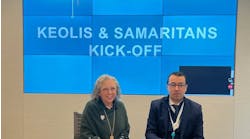Are you getting the most out of your rail safety training?
A critical step in establishing and maintaining a safe rail organization is to provide education and training to ensure personnel can properly and safely execute their tasks. Up until a couple years ago, a common approach to safety training and education was to present the curriculum, probably with a PowerPoint presentation, provide a written test and, if the trainee passed, they were ready to get to work.
“In my experience, there was no real thorough verification to make sure that learning transfer was taking place,” said Rick Bellew, chief safety officer and senior vice president, RailPros.
Instead, to create a safer working environment, organizations should challenge the status quo and execute training for the right reasons— pushing beyond being compliant and promoting a culture of safety.
“Groups are being encouraged to really look internally and analyze themselves for what it is [they] are trying to achieve with [their] training programs and why or why not they effective,” explained Erika Bruhnke, vice president of training services, RailPros.
Creating a Complete Safety Training Program
When thinking about a safety program, organizations should embrace the idea that safety training and education isn’t a singular, passive event where an employee views a presentation and passes a test. Rather, it starts in a classroom setting and continues to be an ongoing, active process that includes mentoring, safety briefings, toolbox talks and on-the-job demonstrations. While the former establishes the building blocks, the latter ensures knowledge has been transferred and the tasks can be performed correctly and safely.
“There are levels of evaluation that determine the depth of which knowledge transfer has occurred. Level one, simply reacting to something that has been learned. [Then] there are other levels going to two, three, four that actually demonstrate a more proficient and a deeper understanding of what has been learned,” said Bruhnke. “We're not just sitting there throwing information at a human and hoping it sticks.”
For instance, at RailPros, its on-the-job training component is designed so that trainees don’t move to the next level or task until they are masters of the task they’re currently being trained in. This creates a strong foundation for “confidence and success,” said Bellew.
“We also do the same thing with the trainers. We make sure that the people [giving the training] are not only designated instructors, but are also masters of their craft,” added Bellew.
Bruhnke notes that being experts in their skillsets is just one part of becoming trainers, mentors and designated instructors.
“We put [them] through a pretty rigorous process to make sure that not only, yes, we have confirmed, they have the experience, they have the knowledge, but also, they have the skill sets to actively teach those topics,” said Bruhnke. “Just because you have the experience and you have the knowledge of the topic being addressed does not automatically qualify you to be an instructor. It does take a different kind of person to be able to connect and teach a student.”
Evaluating the Effectiveness of a Safety Training Program
At RailPros, the designated instructors, trainers and mentors play a critical role in auditing the training, another critical component of any safety training and education program. Auditing trained workers’ performance allows organizations to look for areas of improvement and determine if training played a role, and if so, adjust the program so the errors are addressed.
However, an audit of skillsets should go deeper than just a pass/fail test. It should question why an action is being performed, if it’s being performed completely and that it has been done correctly over a period of time—not just the day of the audit. These findings can then inform refresher courses.
"You've got to figure out what your people are struggling with, identify that need through some form of a skill gap assessment and then go out and focus on that piece that your people are struggling with,” said Bellew.
By analyzing what a training course is trying to achieve and being proactive with skill gap assessments, organizations can save time and money in the long run.
“By taking that brief moment to be more targeted with what it is we're training, we truly are gaining back quite a bit of effort in the future,” explained Bruhnke. “We're making sure [knowledge] transfer has taken place today versus waiting for something to perhaps, unfortunately, find us months down the way.”
Justifying the Cost of Training
If organizations have been operating regularly without incidents, it can be difficult to quantify a return on investment when it comes to training. But organizations should be cautious of having the mindset that they have a safe work environment just because there haven’t been any incidents. In other words, is it safe on accident or on purpose? Instead, consider taking a proactive approach to ensure the program is working and is valuable.
“I can build a PowerPoint for fairly cheap in the comfort of my own home on a computer and it will probably meet the requirements, but am I really providing the value to my team to ensure that they are getting the best product to ensure they can go out there and perform that task to the highest extent possible? Maybe I am, maybe I'm not,” said Bellew.
Creating and auditing a valuable safety program uses resources that need to be justified. So, organizations should start with a needs assessment. Step one is to figure out what is needed to be successful. And this might not include training. Maybe the need can be addressed with a one-on-one conversation, explains Bruhnke.
“That needs analysis is very important to recognize that we are training for the right reasons,” said Bruhnke.
To continue developing a robust safety program, use the needs assessment to develop concrete learning objectives, which also indicate what needs to be evaluated at the end. Next, select the type of learning best suited to the need (i.e. instructor led, e-learning, blended) and a trainer (if applicable), and then start building meaningful material. Feedback comes next to ensure the training will achieve what the needs assessment revealed. Then the organization and instructors should prepare their audiences for the upcoming training. At the end of training, utilize the evaluation data to monitor the success of the course.
“If employers can embrace a complete learning process that ensures the learning transfer has taken place, a safer workforce will be the return on investment worth the efforts,” concluded Bellew.

Megan Perrero | Editor in Chief
Megan Perrero is a national award-winning B2B journalist and lover of all things transit. Currently, she is the Editor in Chief of Mass Transit magazine, where she develops and leads a multi-channel editorial strategy while reporting on the North American public transit industry.
Prior to her position with Mass Transit, Perrero was the senior communications and external relations specialist for the Shared-Use Mobility Center, where she was responsible for helping develop internal/external communications, plan the National Shared Mobility Summit and manage brand strategy and marketing campaigns.
Perrero serves as the board secretary for Latinos In Transit and is a member of the American Public Transportation Association Marketing and Communications Committee. She holds a bachelor’s degree in multimedia journalism with a concentration in magazine writing and a minor in public relations from Columbia College Chicago.



